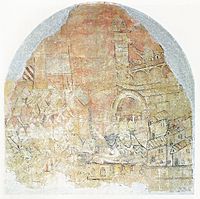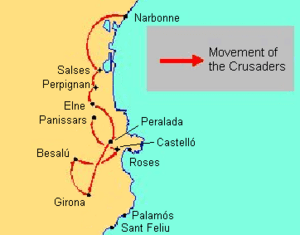Aragonese Crusade facts for kids
Quick facts for kids Aragonese Crusade |
|||||||
|---|---|---|---|---|---|---|---|
| Part of the Crusades and the War of the Sicilian Vespers | |||||||
 A fresco from the Castle of Cardona depicting the Siege of Girona in 1285; now preserved in the Museu Nacional d'Art de Catalunya |
|||||||
|
|||||||
| Belligerents | |||||||
| Commanders and leaders | |||||||
The Aragonese Crusade (1284–1285) was a war fought by the Kingdom of France against the Crown of Aragon. It's also called the Crusade of Aragon. This war was part of a bigger conflict called the War of the Sicilian Vespers. Pope Martin IV started this crusade. He was upset because Peter III of Aragon had gotten involved in Sicily. This hurt the Pope's and France's plans.
The Kingdom of France, with help from the Kingdom of Majorca, led the crusade. Even though some people in France didn't want the war, Philip III of France invaded Catalonia in 1285. The French army had some success on land. However, the Aragonese navy took control of the sea. The French crusader army lost many soldiers and had to retreat in late 1285. This defeat ended the fighting. Aragon later made peace with the Pope in 1291 with the Treaty of Tarascon.
Contents
Why Did the Aragonese Crusade Happen?
This crusade was part of the larger War of the Sicilian Vespers. Pope Martin IV declared it against King Peter III of Aragon in 1284. The Pope was angry because Peter had recently taken control of Sicily. The Pope said that Aragon was a "papal fief." This meant it was a land given to the Pope by a king. Peter's grandfather, Peter II, had given Aragon to the Pope.
Pope Martin IV officially removed Peter III as king. He then gave Aragon to Peter's nephew, Count Charles of Valois. Charles was the son of King Philip III of France.
Family Rivalries and Alliances
The crusade quickly caused a civil war in Aragon. Peter III's brother, King James II of Majorca, joined the French side. James also ruled the County of Roussillon. This land was located between France and Aragon. Peter had not supported James becoming king of Majorca. This old rivalry led James to side with France during the crusade.
Peter's oldest son, who would become Alfonso III, was in charge of defending the border with Navarre. Navarre was ruled by Philip III's son, Philip the Fair. Peter worried about a full invasion from Navarre. But there were only a few small attacks across the border. The king of Navarre joined the main French army with his father.
Major Events of the Crusade
In 1284, the first French armies entered Roussillon. King Philip III and Charles of Valois led them. The army was huge, with 16,000 cavalry (soldiers on horseback), 17,000 crossbowmen, and 100,000 foot soldiers. They also had 100 ships ready in southern French ports.
The Siege of Elne
Even though King James of Majorca supported the French, the local people in Roussillon fought back. The city of Elne was bravely defended. A man known as the Bâtard de Roussillon (Bastard of Roussillon) led the defense. He was the illegitimate son of a former count.
Eventually, the French broke through. The cathedral was burned, even though Pope's representatives were there. Many people in the city were killed. Only the Bâtard survived. He managed to surrender and was taken prisoner by the French army.
The Siege of Girona
In 1285, Philip the Bold set up camp outside Girona to besiege it. The city put up a strong fight, but the French eventually captured it. Charles of Valois was crowned there. However, he didn't have a real crown. On April 28, a cardinal named Jean Cholet placed his own hat on Charles's head. Because of this, Charles was jokingly called roi du chapeau ("king of the hat").
French Setbacks and Retreat
The French soon faced problems. Peter III's admiral, Roger de Lauria, was very skilled. He defeated and destroyed the French fleet at the Battle of Les Formigues. This battle happened off the Catalan coast near Palamós.
Also, a serious illness called dysentery spread through the French army camp. King Philip himself became sick. Philip of Navarre, who was the next in line to the French throne, started talking with Peter III. He wanted safe passage for the royal family through the Pyrenees mountains.
The regular French troops were not offered safe passage. They were badly defeated at the Battle of the Col de Panissars. The king of France, Philip III, died in Perpignan. This city was the capital of James of Majorca. Philip was buried in Narbonne. Peter III of Aragon also died not long after Philip.
What Was the Impact of the Crusade?
Historians have called the Aragonese Crusade "perhaps the most unjust, unnecessary and calamitous enterprise ever undertaken by the Capetian monarchy." This means it was a very bad and harmful war for France.
The crusade had little lasting effect on France. However, Majorca suffered greatly. It lost its independence. Alfonso III, Peter's son, took over Majorca, Ibiza, and Menorca in the years that followed.
Later, in 1295, the Treaty of Anagni returned the islands to James. The Treaty of Tarascon in 1291 officially gave Aragon back to Alfonso. It also lifted the Church's ban against him.
Images for kids
See also
 In Spanish: Cruzada contra la corona de Aragón para niños
In Spanish: Cruzada contra la corona de Aragón para niños




